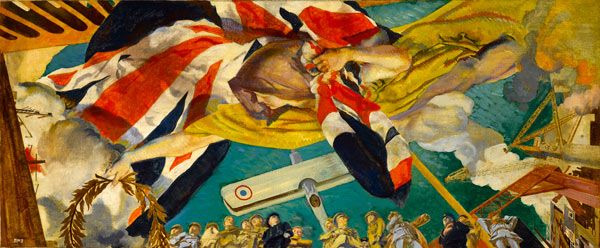
Victory - Study for Ceiling painting in the Great Hall of the Institute of Civil Engineers, c. 1919
Framed (ref: 5480)
Signed
Oil on canvas
45.5 x 109.5 cm (17 15/16 x 43 1/8 in.)
Tags: Charles Sims oil murals WW-1 Paintings

Signed
Oil on canvas
45.5 x 109.5 cm (17 15/16 x 43 1/8 in.)
Tags: Charles Sims oil murals WW-1 Paintings
Provenance: Private Collection
In 1920 Sims was commissioned to decorate the ceiling of the Institute of Civil Engineers in Great George Street, Westminster. On December 2,
1919 the Institute’s Minutes recorded the Council’s decision ‘that advantage be taken of the opportunity afforded of the cleaning and reinstatement of the Great Hall, and the erection of scaffolding therefore, to complete the architect’s original scheme for the decoration for the decoration of the mouldings of the ceiling …
The Council accept the offer of Sir John Griffith the President, to complete the ceiling of the Great Hall by providing for the decoration of the central panel a painting emblematic of the Civil Engineers’ war-time efforts.’ The ceiling decoration was part of a commemorative scheme, including a plaque designed by Derwent Wood to record the names of those members killed in the Great War.
Sims’s design is enormously inventive. A figure of Victory swoops down, surrounded by a billowing Union Jack and holding the victor’s laurels, although it also serves as a wreath for the dead. At the edges people crane their necks to peer upwards, as people looking up at the ceiling would do, and a biplane, emblem of modernity crosses the composition. Sims was deeply engaged in the process commemorating the War. His son was killed in the Navy in 1914, and he painted a lamentation that was exhibited at the Royal Academy to great note. In 1918 he travelled to France as an Official War Artist and was there when the guns fell silent for the Armistice. Sims was paid £1,000 for his Civil Engineers ceiling commission. The fully completed canvas exhibited here was perhaps used to show the Council what form the final decoration would take.
IN 1919 Lady Astor became the first woman to take her seat in parliament; The exclusion of women from many jobs is made illegal - women could now become magistrates, solicitors and barristers.